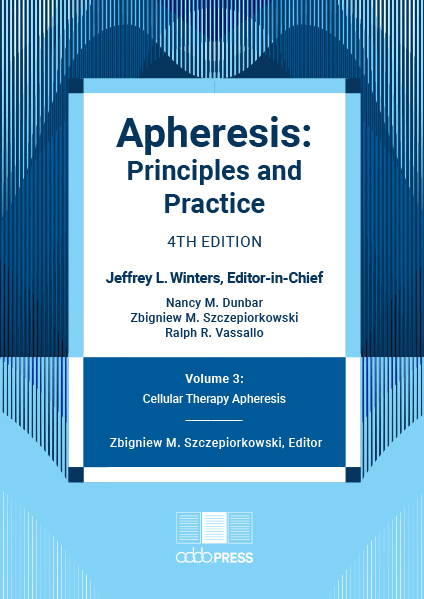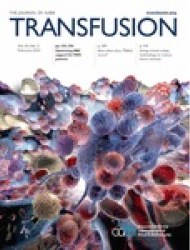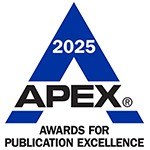
Since its first publication, Apheresis: Principles and Practice has served as a valuable resource for the field of transfusion medicine and biotherapies. Currently in its fourth edition, the reference book has evolved throughout the years, expanding into three separate volumes with the new edition to provide a comprehensive account of the scientific, technical and practical aspects of apheresis: therapeutic apheresis (Volume 1); donor apheresis (Volume 2) and cellular therapy (Volume 3).
Published in 2025, the latest volume is dedicated to apheresis practice and the collection of products in the ever-growing field of cellular therapy and biotherapeutics. From cellular therapy donor evaluation to applications for extracorporeal photopheresis, each chapter was designed to help practitioners better understand their role in the complex process of creating cellular therapy products.
AABB News spoke to Jeffrey Winters, MD, editor-in-chief of the Apheresis Principles and Practice, 4th edition (Volume 3) about the editing process and what readers can expect from the latest release. Winters noted this edition serves as a comprehensive reference that can support readers at all levels, providing foundational knowledge across therapeutic, donor and cellular therapy topics for trainees, residents, clinicians and researchers. He also emphasized that this volume would be particularly useful as a reference for readers seeking the latest information in the rapidly evolving field of cellular therapies. For experienced practitioners, it offers more detailed, nuanced information to support practice and decision-making.
“One of the reasons for splitting the book into three volumes for this edition was to allow for independent updates. The landscape keeps changing, so we need to keep up with those developments,” Winters said. “The third volume is up to date with where the science currently stands, as well as available products, billing changes and quality focus. It’s designed to answer both common and complex questions, so it’s useful no matter your level of experience.”
Winters discussed the process of leading the massive editorial project, which required a collaborative effort – throughout the course of several years – among editors, authors and publishers to ensure consistency in voice, formatting and content, tone, tables and figures.
“Each volume had a dedicated editor who worked with authors, especially on early drafts. After that, I reviewed the drafts and provided feedback. Then AABB Press stepped in; Laurie Monk and Jennifer Boyer were especially instrumental in reviewing and refining content,” Winters explained. “Layout editors also made small changes to ensure a consistent reading experience across all chapters and volumes. It went through many iterations to ensure quality and consistency.”
With more than 30 contributors, Winters cited managing multiple authors, dealing with unforeseen delays and ensuring timely, relevant submissions as the project’s main challenges.
“The third volume is up to date with where the science currently stands, as well as available products, billing changes and quality focus.”
“We faced delays with the third volume, partly due to life events affecting some of the contributors, including myself, and also because the cellular therapy field is evolving so quickly,” Winters said. “We'd write a section, then have to revise it because it was already out of date. That ongoing evolution made things difficult.”
For the author selection process, each editor of the three volumes recruited experts in their respective areas through personal networks and institutional connections with Winters performing final academic background checks on proposed authors. For example, in Volume 1, many contributors were involved with the American Society for Apheresis guidelines and had already been vetted as domain experts, Winters explained.
“Authors were also encouraged to collaborate with colleagues or trainees to bring fresh perspectives and involve early-career professionals,” he said. “I reviewed the proposed author lists, vetting backgrounds and publication history to ensure we had a balance—ideally combining seasoned experts with newer voices.”
Winters, chair of the division of transfusion medicine at the Mayo Clinic in Rochester, Minn., expressed his satisfaction with the final outcome, noting the positive reception and application among colleagues and trainees.
“This volume serves as a valuable reference. I’ve read all the chapters multiple times, and I’ve learned something from each one, despite my experience in the field,” Winters said. “It’s hard to choose a favorite chapter because they all bring something important to the table.”
Winters mentioned preliminary discussions about updating the first volume for the next edition, potentially in 2026, particularly in light of new guidelines from the American Society for Apheresis.
“There is potential for the addition of new diseases as well as changes to both the ASFA categories and recommendation grades,” he said. “Volume Two may not need updating as soon because there haven’t been many recent changes in regulation or equipment, and Volume Three is brand new, so we’ll give that some time. But we’re thinking ahead, and I’ve already started considering potential editors for the next update.”
Now that the editing project is complete, Winters said he is looking forward to his upcoming speaking engagement at the 2025 AABB Annual Meeting and is currently focused on planning the transfusion laboratory for Mayo Clinic’s new hospital, scheduled to open in 2030.
“We’re also working to increase blood donations at our hospital-based donor center and making updates in our therapeutic apheresis treatment unit,” Winters said. “I wouldn’t say I have much downtime these days, but when I do have time, I enjoy spending it with my wife and our two adult children, who are both doing well and making us proud. That’s where I find joy outside of work.”
*To learn more about the Apheresis: Principles and Practice, 4th Ed, Volume 3: Cellular Therapy Apheresis and to purchase a copy, visit the AABB Store.
PREVIOUS STORY
In Conversation with James Taylor, MD: How Howard University is Transforming Sickle Cell TreatmentBACK TO ISSUE
September 2025NEXT STORY
White Coats: Nabiha Huq Saifee MD, PhD
Transfusion is AABB’s scholarly, peer-reviewed monthly journal, publishing the latest on technological advances, clinical research and controversial issues related to transfusion medicine, blood banking, biotherapies and tissue transplantation. Access of Transfusion is free to all AABB members.
Learn More About Transfusion Journal
Keep abreast of what's happening in the field of biotherapies with CellSource - AABB's monthly update on the latest biotherapies news.
To submit news about the blood and biotherapies field to AABB, please email news@aabb.org.
President
Meghan Delaney, DO, MPH
Chief Executive Officer
Debra Ben Avram, FASAE, CAE
Chief Communications and Engagement Officer
Julia Zimmerman
Director of Marketing and Communications
Jay Lewis, MPH
Managing Editor
Kendra Y. Mims, MFA
Senior Communications Manager
Drew Case
AABB News
(ISSN 1523939X) is published monthly, except for the combined November/December issue for the members of AABB; 4550 Montgomery Avenue; Suite 700 North Tower; Bethesda, MD 20814.
AABB is an international, not-for-profit association representing individuals and institutions involved in transfusion medicine, cellular therapies and patient blood management. The association is committed to improving health by developing and delivering standards, accreditation and educational programs that focus on optimizing patient and donor care and safety.
+1.301.907.6977
Email: news@aabb.org
Website: www.aabb.org
Copyright 2025 by AABB.
Views and opinions expressed in AABB News are not necessarily endorsed by AABB unless expressly stated.
Notice to Copiers: Reproduction in whole or part is strictly prohibited unless written permission has been granted by the publisher. AABB members need not obtain prior permission if proper credit is given.
